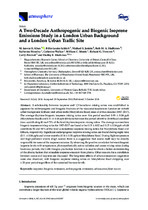| dc.contributor.author | Shallcross, Dudley E. | |
| dc.date.accessioned | 2019-10-18T10:30:54Z | |
| dc.date.available | 2019-10-18T10:30:54Z | |
| dc.date.issued | 2018-10-03 | |
| dc.identifier.citation | Shallcross, Dudley E. et al. (2018) "A Two-Decade Anthropogenic and Biogenic Isoprene Emissions Study in a London Urban Background and a London Urban Traffic Site." Atmosphere 9, no. 10: 387. | en_US |
| dc.identifier.issn | 2073-4433 | |
| dc.identifier.uri | http://hdl.handle.net/10566/5047 | |
| dc.description.abstract | A relationship between isoprene and 1,3-butadiene mixing ratios was established to
separate the anthropogenic and biogenic fractions of the measured isoprene in London air in both
urban background (Eltham) and urban traffic (Marylebone Road) areas over two decades (1997–2017).
The average daytime biogenic isoprene mixing ratios over this period reached 0.09 ± 0.04 ppb
(Marylebone Road) and 0.11 ± 0.06 ppb (Eltham) between the period of 6:00 to 20:00 local standard
time, contributing 40 and 75% of the total daytime isoprene mixing ratios. The average summertime
biogenic isoprene mixing ratios for 1997–2017 are found to be 0.13 ± 0.02 and 0.15 ± 0.04 ppb which
contribute 50 and 90% of the total summertime isoprene mixing ratios for Marylebone Road and
Eltham, respectively. Significant anthropogenic isoprene mixing ratios are found during night-time
(0.11 ± 0.04 ppb) and winter months (0.14 ± 0.01 ppb) at Marylebone Road. During high-temperature
and high-pollution events (high ozone) there is a suggestion that ozone itself may be directly
responsible for some of the isoprene emission. By observing the positive correlation between biogenic
isoprene levels with temperature, photosynthetically active radiation and ozone mixing ratios during
heatwave periods, the Cobb-Douglas production function was used to obtain a better understanding
of the abiotic factors that stimulate isoprene emission from plants. Other reasons for a correlation
between ozone and isoprene are discussed. The long-term effects of urban stressors on vegetation
were also observed, with biogenic isoprene mixing ratios on Marylebone Road dropping over
a 20-year period regardless of the sustained biomass levels. | en_US |
| dc.description.sponsorship | NERC (grant code-NE/K004905/1) and Bristol ChemLabS under whose auspices various
aspects of this work was funded.
Department for Environment, Food and Rural Affairs (Defra) and London Air
Quality Network-King’s College London for supporting UK monitoring network and data | en_US |
| dc.language.iso | en | en_US |
| dc.publisher | MDPI | en_US |
| dc.subject | Isoprene | en_US |
| dc.subject | Biogenic emissions | en_US |
| dc.subject | Anthropogenic emissions | en_US |
| dc.subject | Heat waves | en_US |
| dc.subject | Urban areas | en_US |
| dc.title | A Two-Decade Anthropogenic and Biogenic Isoprene Emissions Study in a London Urban Background and a London Urban Traffic Site | en_US |
| dc.type | Article | en_US |

